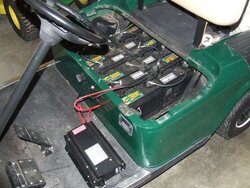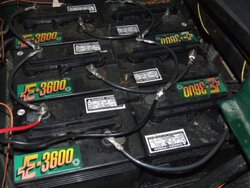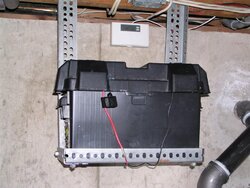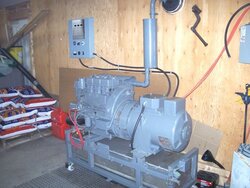A potential problem with some pellet stove installations is that the stove may backdraft in the event of a power failure, possibly filling the living space with smoke. My Mom's Whitfield Advantage II T Insert has filled her house with smoke several times over the 20+ years she's owned it, fortunately her power rarely goes out.
The one time that really stands out in my mind is one New Years Day morning a few years back. We had all stayed up until well after midnight ringing in the new year, and finally passed out about 1:30am. I awoke about 5:30am to the sound of smoke alarms and a house full of smoke. It was freezing cold outside and the power was out. The only thing we could do was open some doors and windows and try and air out the smoke. Needless to say, the entire house was freezing cold in a very short time. The power did not come back on for several hours and the smoke was slow to exit without the help of some fans. That was an experience I didn't want to repeat anytime soon.
For a while after that we would shut down the stove if we felt that there was the possibility of the power going off becuase of an approaching snow or ice storm, but this was precisely the time we wanted to be sitting in front of the nice warm fire. So I began to research backup power options for the pellet stove.
The ultimate solution of course would be to have a stationary, whole house generator, that would automatically come on and keep all of my appliances running. But I was most interested in a quick, inexpensive solution to preventing the house from filling with smoke during the infrequent, short power outages. Being an IT person I immediately thought of the battery backups used to keep computers on long enough to shut them down properly during a power outage.
As a quick experiment, I measured the electrical consumption of the pellet stove with a P3 Kill A Watt EZ Meter http://www.amazon.com/P3-Internatio...1?ie=UTF8&s=electronics&qid=1297024532&sr=8-1 (see my other post - electrical consumption of pellet stoves), and compared that to the specs given on several different APC battery backup units I had. I selected one of the larger units, a Backups 650, which should have enough power to run the stove for long enough to shut it down and prevent the back draft problem. I connected the unit to the stove, and with the stove burning, pulled the power cord of the backup unit out of the wall outlet to simulate a power outage. The stove kept burning with no problems. I plugged the power cord back in and the backup unit switched back to wall power without a hitch. Everything seemed good, as long as the battery would last long enough for the stove to shut down, this was a possible solution.
But what about the power quality of the APC backup unit? How does it compare to what comes out of a wall outlet? Is it safe to run my pellet stove electronics from this power source? If it can power the sensitive electronics of a computer it must be okay to run my pellet stove for a few minutes right? Not necessarily! These same questions could (and should) be asked about generators as well. I did some investigating into the output power quality of various backup power devices and was surprised by what I found. What is okay for the DC electronics of a PC to run on, might not necessarily be okay to run the AC motors of your pellet stove.
Ultimately, you would like your backup power device to output a power signal that looks as close as possible to the waveform that is delivered by your utility company. In the U.S., for standard 120 volt wall recepticles this waveform is a fairly smooth sine wave, with a consistent amplitude and frequency of 120 volts and 60 hz.
Here's a great article I discovered in my research that compares the outputs of several common backup power devices, and shows pictures of their output waveforms on an oscilloscope for comparison. I hope this information will help others to select a quality backup power source for their stoves, and avoid potential costly problems caused by using poor quality power devices. No one wants to replace motors and control boards unneccesarily.
Power Quality Produced by Various Backup Devices
http://www.jkovach.net/projects/powerquality/
Anyone else here in the forum care to share their pellet stove backup power solution? I'd love to see them!
The one time that really stands out in my mind is one New Years Day morning a few years back. We had all stayed up until well after midnight ringing in the new year, and finally passed out about 1:30am. I awoke about 5:30am to the sound of smoke alarms and a house full of smoke. It was freezing cold outside and the power was out. The only thing we could do was open some doors and windows and try and air out the smoke. Needless to say, the entire house was freezing cold in a very short time. The power did not come back on for several hours and the smoke was slow to exit without the help of some fans. That was an experience I didn't want to repeat anytime soon.
For a while after that we would shut down the stove if we felt that there was the possibility of the power going off becuase of an approaching snow or ice storm, but this was precisely the time we wanted to be sitting in front of the nice warm fire. So I began to research backup power options for the pellet stove.
The ultimate solution of course would be to have a stationary, whole house generator, that would automatically come on and keep all of my appliances running. But I was most interested in a quick, inexpensive solution to preventing the house from filling with smoke during the infrequent, short power outages. Being an IT person I immediately thought of the battery backups used to keep computers on long enough to shut them down properly during a power outage.
As a quick experiment, I measured the electrical consumption of the pellet stove with a P3 Kill A Watt EZ Meter http://www.amazon.com/P3-Internatio...1?ie=UTF8&s=electronics&qid=1297024532&sr=8-1 (see my other post - electrical consumption of pellet stoves), and compared that to the specs given on several different APC battery backup units I had. I selected one of the larger units, a Backups 650, which should have enough power to run the stove for long enough to shut it down and prevent the back draft problem. I connected the unit to the stove, and with the stove burning, pulled the power cord of the backup unit out of the wall outlet to simulate a power outage. The stove kept burning with no problems. I plugged the power cord back in and the backup unit switched back to wall power without a hitch. Everything seemed good, as long as the battery would last long enough for the stove to shut down, this was a possible solution.
But what about the power quality of the APC backup unit? How does it compare to what comes out of a wall outlet? Is it safe to run my pellet stove electronics from this power source? If it can power the sensitive electronics of a computer it must be okay to run my pellet stove for a few minutes right? Not necessarily! These same questions could (and should) be asked about generators as well. I did some investigating into the output power quality of various backup power devices and was surprised by what I found. What is okay for the DC electronics of a PC to run on, might not necessarily be okay to run the AC motors of your pellet stove.
Ultimately, you would like your backup power device to output a power signal that looks as close as possible to the waveform that is delivered by your utility company. In the U.S., for standard 120 volt wall recepticles this waveform is a fairly smooth sine wave, with a consistent amplitude and frequency of 120 volts and 60 hz.
Here's a great article I discovered in my research that compares the outputs of several common backup power devices, and shows pictures of their output waveforms on an oscilloscope for comparison. I hope this information will help others to select a quality backup power source for their stoves, and avoid potential costly problems caused by using poor quality power devices. No one wants to replace motors and control boards unneccesarily.
Power Quality Produced by Various Backup Devices
http://www.jkovach.net/projects/powerquality/
Anyone else here in the forum care to share their pellet stove backup power solution? I'd love to see them!






